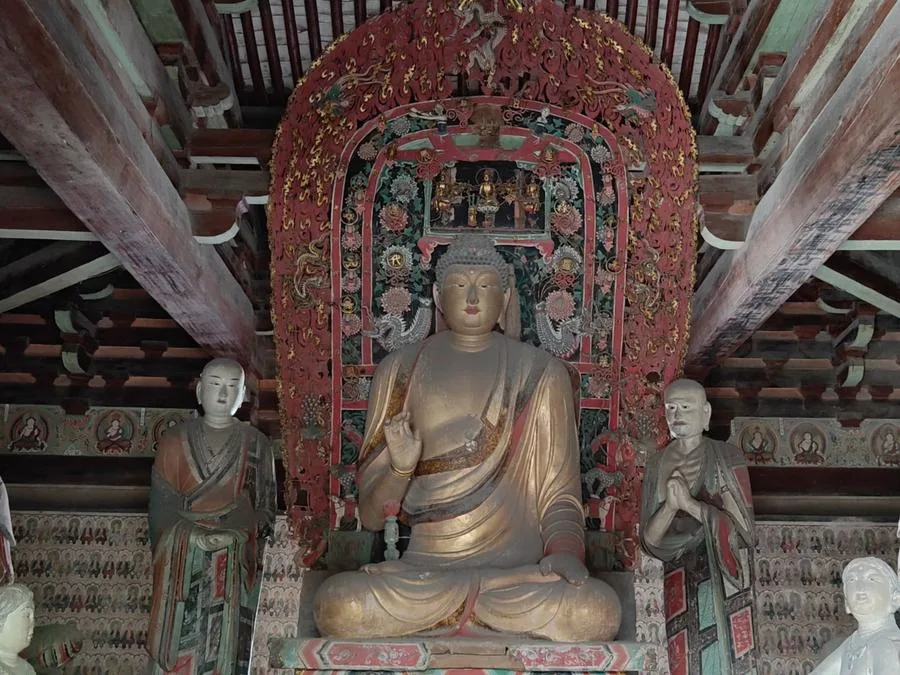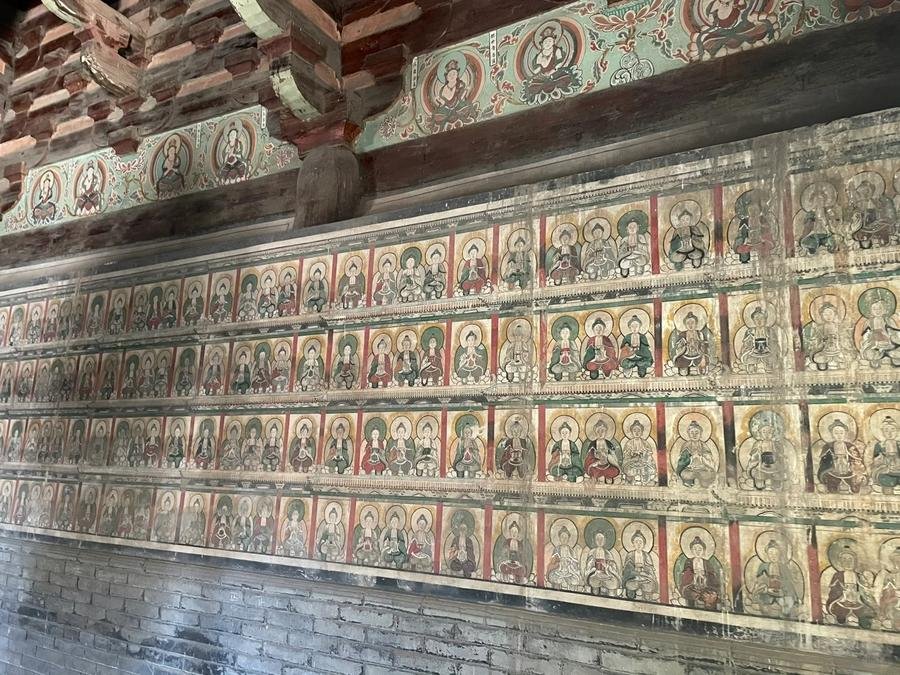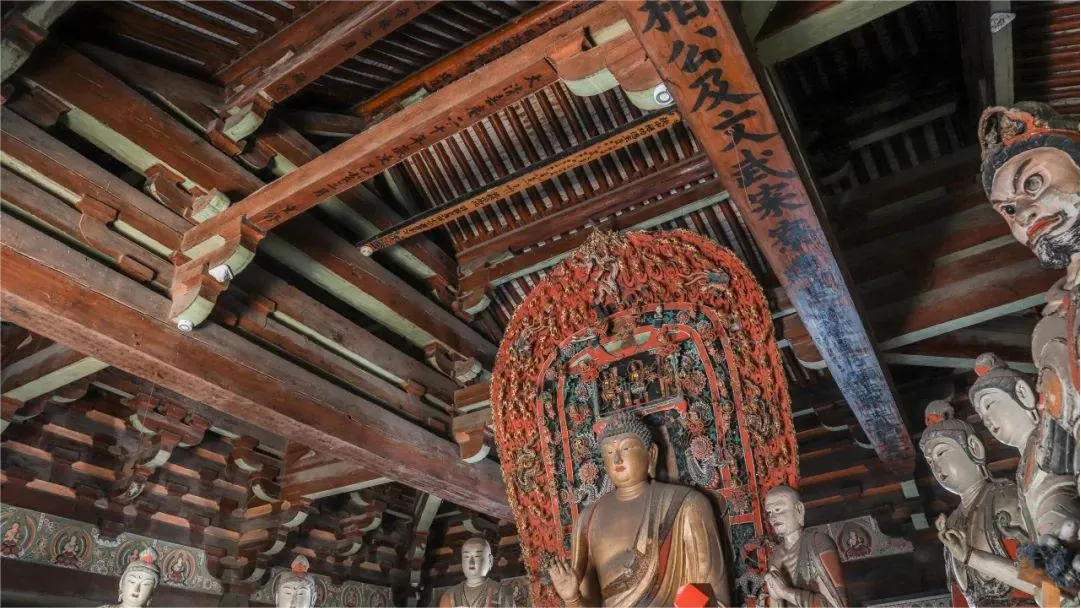Zhenguo Temple (镇国寺), originally named Jingcheng Temple, was founded in the 7th year of the Tianhui era during the Northern Han period (963 AD). It was renamed Zhenguo Temple during the Ming Jiajing era and has retained this name to the present day. The temple has undergone multiple renovations and reconstructions throughout the Jin, Yuan, Ming, and Qing dynasties. Currently, it consists of two courtyards oriented north to south.
The most notable building within the temple is the Wanfo Hall, which is the oldest structure on site. Despite numerous renovations over the centuries, it still preserves the architectural style from the Five Dynasties period, making it one of the three existing Five Dynasties buildings in China. The colorful sculptures within the hall are the only surviving examples of Five Dynasties art in the country’s temples.
During the Five Dynasties period, the Northern Han, which controlled only a small part of central and southern Shanxi Province, faced significant pressure from the Zhou dynasty. To seek the protection of the Buddha, the Northern Han government heavily promoted Buddhism and extensively repaired and constructed temples within its territory.
Zhenguo Temple houses several invaluable historical artifacts. Notably, the temple features a half-stone tablet from the Five Dynasties period, located in the east and west stele pavilions. This fragmentary text provides insights into the court struggles of the Northern Han dynasty, offering crucial references for the study of the Five Dynasties and Ten Kingdoms period.
Table of Contents
- Basic Information
- Location and Transportation
- Highlights of Zhenguo Temple
- Vlog about Zhenguo Temple
- Other Attractions in Pingyao Ancient City
Basic Information
| Estimated Length of Tour | 1 – 2 hours |
| Ticket Price | 25 RMB |
| Opening Hours | 8.00 – 19.00; Last admission: 18.30 |
| Telephone Number | 0086-0354-5848041 |
Location and Transportation
Zhenguo Temple is located in Haodong Village, 15 kilometers northeast of Pingyao County, Jinzhong City, Shanxi Province. To reach the temple, take bus route 209 from the North Gate of Pingyao Ancient City. The bus fare is 4 yuan per ride, and it operates every 40 minutes.
Highlights of Zhenguo Temple
Wanfo Hall

Wanfo Hall is the main hall of Zhenguo Temple. The beams inside the hall still bear an inscription from the time of its construction, stating “维大汉天会七年建造 (Built in the 7th year of the Tianhui era of the Northern Han Dynasty).” The hall is three bays wide and deep, with a single-eaved, nine-tiered hip roof. The entire structure is made from interlocking wooden joints without any nails. The façade of the hall features windows on either side, with a door at the front and back that provides access to the rear courtyard.
The hall’s walls are thick, with an eaves height of 5.27 meters, eaves projection of 2.94 meters, and a total height of 8.87 meters. It is supported by 12 wooden columns, each 3.42 meters high and 0.46 meters in diameter, which are embedded within the walls to prevent decay from moisture. Ingeniously, small ventilation holes are carved at the base of each column on the outer wall to ensure longevity and prevent rot.
Colored Sculptures

Inside Wanfo Hall at Zhenguo Temple, there are 11 colored sculptures from the Five Dynasties period. Apart from a few remaining examples in the Dunhuang Mogao Caves, these Five Dynasties sculptures at Zhenguo Temple are unique and hold a prominent place in the history of Chinese art and sculpture. The 11 sculptures include one Buddha, two disciples, two Bodhisattvas, two attendants, two Vajras, and two donors. Each figure is remarkably lifelike and vivid.
The main statue represents the Buddha Shakyamuni, adorned in gold, with a serene and majestic demeanor. The right forearm and hand are extended outward. To prevent potential breakage due to the downward force over time, the sculptor ingeniously added a carved lotus flower beneath the forearm, both solving the issue of possible damage and adding an elegant and unique touch to the sculpture. The Buddha’s pedestal is a Sumeru throne, but it lacks the eight great strength figures and lotus decorations typical of Ming and Qing Dynasty Buddhist thrones.
The Buddha’s aureole is intricately carved, with a base color of gold dust and flames. It features detailed sculptures of golden dragons in motion, colorful phoenixes spreading their wings, and peacocks displaying their feathers, incorporating elements of ethnic culture and auspicious symbolism. At the base, the sculptures of a blue lion and a white elephant are vividly rendered and dynamic in appearance.
Buddhist Story Murals

Zhenguo Temple houses over 100 existing murals, among which 52 depict stories from the life of the Buddha. These murals are located in the Three-Buddha Hall at the end of the temple’s central axis. The murals are divided into separate panels, creating independent units that collectively form a long narrative about the Buddha’s life. The artwork is organized so that the scenes flow coherently from one to the next, each section developing its own storyline while contributing to the overall narrative.
Each mural is accompanied by inscriptions that concisely summarize the content. The paintings trace the life of Shakyamuni Buddha, from his birth, renunciation, and ascetic practice to his enlightenment and Nirvana. The themes are clear, the stories are moving, and the selection of scenes is both precise and legendary. Although there are not many figures, their expressions, features, clothing, and postures are meticulously and powerfully rendered.














